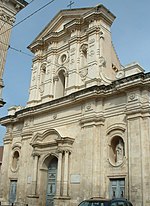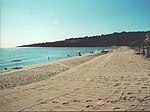Naval Air Station (NAS) Sigonella (IATA: NSY, ICAO: LICZ) is an Italian Air Force base (Italian: Aeroporto "Cosimo Di Palma" di Sigonella), and a U.S. Navy installation at Italian Air Force Base Sigonella in Sicily, Italy. The whole NAS is a tenant of the Italian Air Force, which has the military and the administrative control. It serves as an Italian base for the 41º Stormo Antisom (41st Antisubmarine Warfare Wing).
NAS Sigonella acts also as landlord to more than 40 other U.S. commands and activities. It is located 15 km (8 NM) west and 11 km (6 NM) south of the city of Catania, and some 40 km (22 NM) south of Mount Etna.
The NAS is located in the western part of the large airport structure, while the Italian military base is located in the eastern part.
Because of its location near the center of the Mediterranean Sea, NASSIG is well placed to support operations by the U.S. 6th Fleet, other U.S. military units, and U.S. allies and coalition partners.
Among the aircraft that fly from this island base are Italian Air Force ATR 72MP ( which replaced the Breguet Br.1150 Atlantic in 2017) and United States Air Force C-130, C-17 and C-5 airlifters, KC-135 and KC-10 tankers and U.S. Navy P-8 Poseidons, C-2 Greyhounds, and C-40A Clippers.
It is one of the most frequently used stops for U.S. airlift aircraft bound from the continental United States to Southwest Asia and the Indian Ocean.
NAS Sigonella has the best claim to be hub of U.S. naval air operations in the Mediterranean. The base command is landlord to more than 40 other U.S. units. Among the largest are a rotating P-8A patrol squadron; a Naval Computer and Telecommunications Station; and a U.S. Naval Hospital. The hospital was built in 1992. Previously, there was only a clinic and the closest U.S. Naval Hospital was at Naples. Sigonella is home to more than 4,000 troops, civilian personnel, and family members.
NAS Sigonella is the Navy's second largest security command, second only to that located at Naval Support Activity Bahrain. NAS Sigonella also has a large support of security personnel from NR NSF Sigonella, a Navy Reserve command based in NRC Detroit at Selfridge ANGB, Michigan.
The Naval Air Station comprises two sections: NAS I was the site of the original U.S. base but is now a support facility, and NAS II which includes the runways, operations and most tenant commands. NAS I also contains the Navy Exchange and Commissary, the school, and some homes, mainly for the commodore of Task Force 67, the air station commanding officer, air station executive officer and commanding officers of tenant activities. NAS I also is host to other facilities, mainly for entertainment. NAS II is now only used as a service base.










